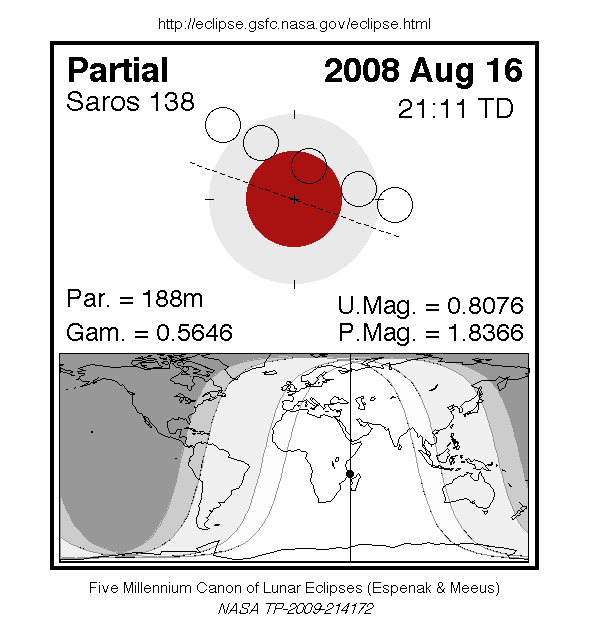A partial eclipse of the Moon occurred on Saturday 16 August, 2008 UT, lasting from 18:24–23:55 UT. The Moon was strikingly shadowed in this deep partial eclipse which lasted 3 hours and 8 minutes, with 81% of the Moon in darkness at maximum. The eclipse was visible over most of Asia, Australasia, Europe, Africa, and south America.
The timings of the phases of the eclipse are as
follows. You would have been able to see each phase of the
eclipse if the Moon was up at the corresponding time as
seen from your location; however the penumbral phase
would have been very difficult to see in practice:
| Penumbral eclipse began: |
18:24:50 UT |
| Partial eclipse began: |
19:36:05 UT |
| Maximum eclipse: |
21:10:06 UT |
| Partial eclipse ended: |
22:44:13 UT |
| Penumbral eclipse ended: |
23:55:21 UT |
During this eclipse the Moon was 6 days after apogee and 9 days before perigee.
At maximum eclipse it was 0.520° in apparent
diameter, which is 2.1% smaller than average.
The statistics page has information on the ranges of the sizes of
the Sun and Moon, and the Moon data page displays detailed
information on the Moon's key dates.
Interactive Map
This map shows the visibility of the eclipse. The bright area in the
middle saw the whole eclipse; the yellow band to the right saw
the start of the eclipse, and the blue band to the left saw the
end. Note that the map is approximate,
and if you were near the edge of the area of visibility, the moon was
very close to the horizon and may not have been practically visible.
You can use the zoom controls to zoom in and out, and pan to
see areas of interest. Hover your mouse over the
tags to see what was visible from each area on the map. The green
marker in the centre shows where the Moon was directly
overhead at maximum eclipse.
The interactive map is currently not available.
Overview Map
This map sourced from NASA Goddard Space flight Center: GSFC Eclipse Web SiteGSFC Eclipse Web Site
The primary source of all the information on eclipses presented here at Hermit Eclipse. (NASA Goddard Space flight Center)
shows the visibility of the eclipse. (Click on it for the
full-sized version.)
Eclipse Season and Saros Series
This eclipse season contains 2 eclipses:
This was the 28th eclipse in lunar Saros series 138.The surrounding eclipses in this Saros series are:
This Saros series, lunar Saros series 138,
is linked to solar Saros series 145. The
nearest partner eclipses in that series are:
Eclipse Parameters
| UT Date/time (max) | 21:10:06 on 16 Aug UT |
TDT Date/time (max) | 21:11:12 on 16 Aug TDT |
| Saros Series | 138 |
Number in Series | 28 |
| Penumbral Magnitiude | 1.8366 |
Central Magnitiude | 0.8076 |
| Gamma | 0.5646 |
Path Width (km) | |
| Delta T | 1m06s |
Error | ± 0m00s (95%) |
| Penumbral Duration | 5h31m |
Partial Duration | 3h08m |
| Total Duration | |
| |
| Partial Rating | |
Total Rating | |
| Sun Distance | 151455434 km (90.2%) |
Moon Distance | 389181 km (65.2%) |
| Sun Diameter | 0.527° |
Moon Diameter | 0.511° - 0.520° |
| Apogee | 20:19 on 10 Aug UT |
Perigee | 03:45 on 26 Aug UT |
| Contact p1 | 18:24:50 on 16 Aug UT |
Contact p2 | |
| Contact u1 | 19:36:05 on 16 Aug UT |
Contact u2 | |
| Max eclipse | 21:10:06 on 16 Aug UT |
| Contact u3 | |
Contact u4 | 22:44:13 on 16 Aug UT |
| Contact p3 | |
Contact p4 | 23:55:21 on 16 Aug UT |
Note that while all dates and times on this site (except
where noted) are in UT, which is within a second of civil time,
the dates and times shown in NASA's eclipse listingsGSFC Eclipse Web Site
The primary source of all the information on eclipses presented here at Hermit Eclipse. (NASA Goddard Space flight Center)
are in the TDT timescale.
The Sun and Moon distances are shown in km, and as a
percentage of their minimum - maximum distances; hence 0%
is the closest possible (Earth's perihelion, or the
Moon's closest possible perigee) and 100% is
the farthest (aphelion, the farthest apogee).
The statistics page has information on the ranges of sizes
of the Sun and Moon, and the Moon data page displays detailed
information on the Moon's key dates.
Data last updated: 2015-06-21 22:11:46 UTC.

